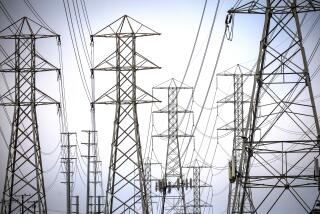SDG&E; Says Rates to Rise if Navy Builds Own Plants
SAN DIEGO â Residential electric rates charged by San Diego Gas & Electric will increase by at least $40 million annually if the U.S. Navy proceeds with a plan to bypass the utility and build three of its own electric generating plants, SDG&E; warned Friday.
The three proposed plants, which would generate a total of 150 megawatts of electricity, would trim the Navyâs $80-million electric bill by $15 million, insulate the bases from future electrical shortages and bolster Navy defenses against possible terrorist actions, Navy officials said Friday.
However, if SDG&E; loses its largest electric customer, residential rates would increase by at least $40 million annually, or about $2 a month for the âaverageâ customer, to cover the utilityâs fixed, operating costs, SDG&E; Chairman and Chief Executive Tom Page said Friday.
SDG&E;, which has waged an âaggressive campaignâ since early this year to keep the Navy from pulling up anchor, has agreed to tailor its rates to match the Navyâs proposed savings, Page said.
And, Page said, the Navyâs savings estimate did not take into account recently approved rate reductions that make SDG&E;âs electric rates more attractive to large industrial users such as the Navy.
Any deal arranged to keep the Navy as an SDG&E; customer would require state Public Utilities Commission approval because residential rates probably would rise, Page said.
If the Navy rejects SDG&E;âs lower rates, Page pledged that the utility would ask Congress to prohibit the âinherently unfairâ generating plan.
The Navy, which developed the self-generation plan last year, will not seek project bids until an economic feasibility study is completed in about a month, according to H.R. Frauenfelder, commanding officer of the Navyâs Civil Engineer Corps in San Diego.
The plan to build generating plants at the Navyâs 32nd Street Station, North Island Naval Air Station and the Marine Corps Recruit Depot hinges upon economic data being prepared by Long Beach-based Burnes & Roe.
The Navy probably would abandon its generating plant scheme if the report proves that SDG&E;âs rate package is more economical, Frauenfelder said.
The Navy wants to cut its electric bills because utility payments now account for 10% of its operating costs in San Diego, according to Frauenfelder. SDG&E;âs electric rates are âthe highest at any Navy base in the United States,â he said.
Even if the Navy drops the self-generation plan, its San Diego bases probably would increase dependence upon so-called co-generation plants that, for more than 10 years, have produced industrial process steam.
The plants also produce electricity which is sold to SDG&E; by Energy Factors, a San Diego-based company that operates co-generation plants at the Naval Training Center, the Marine Corps Recruit Depot and the 32nd Street Station.
Energy Factors âagrees with SDG&E; that the Navy should look at current economics before moving ahead with their (self-generation) proposal,â Energy Factors Vice President Rick Kay said Friday. âThere have been significant rate changes which (create) the possibility for significant rate savings since the first of the year.â
More to Read
Inside the business of entertainment
The Wide Shot brings you news, analysis and insights on everything from streaming wars to production â and what it all means for the future.
You may occasionally receive promotional content from the Los Angeles Times.










